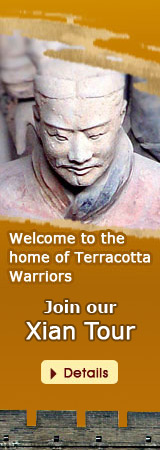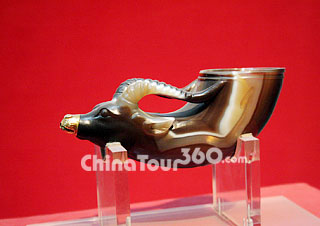 Agate Cup, Tang Dynasty
Agate Cup, Tang Dynasty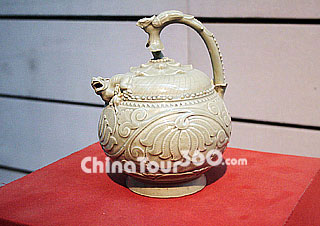 A Porcelain Pot, Song Dynasty
A Porcelain Pot, Song Dynasty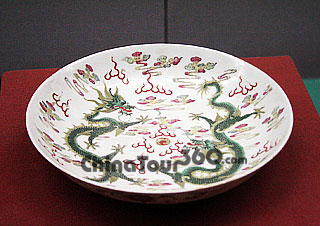 A Porcelain Plate, Tang Dynasty
A Porcelain Plate, Tang Dynasty A Gold Monster
A Gold Monster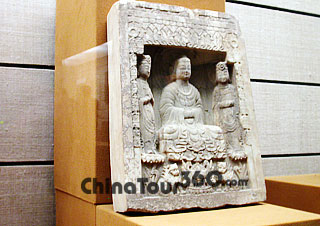 Carved Stone
Carved Stone
Situated on Yanta Road in City of Xian, Shaanxi History Museum lies to the northwest of the Big Wild Goose Pagoda. It is the first large national museums with modern facilities in China. Occupying a total area of 65,000 square meters (16 acres), it has a building area of 55,600 square meters (13.7 acres), cultural relic's storerooms of 8,000 square meters (2 acres), exhibition halls of 11,000 square meters (2.7 acres), and a collection of 370,000 objects.
Looking elegant and dignified, the museum was built in the Tang Dynasty (618 - 709) style, with a 'hall in center, storied buildings in corners'. It is really a combination of traditional architecture and modern technology, which embodies folk tradition and local features.
Exhibited in the main exhibition hall are 2,700 works of art, with an exhibition line that extends 2,300 meters (2,512 yards). The exhibition area is divided into an introductory hall, permanent exhibitions, special exhibitions, and temporary exhibitions, as well as one that has been named the National Painting Hall.
The Museum's permanent exhibition primarily displays Shaanxi's ancient history. Representative pieces from all periods have been selected to show the development of civilization in this region. The exhibition space of this display is 4,600 square meters (1.1 acres). It includes three exhibition rooms, divided into seven parts: Pre-history Period (1.7 million years ago - 21st Century BC), Zhou Dynasty (11th Century - 771 BC), Qin Dynasty (221 - 207 BC), Han Dynasty (206 BC - 220 AD), Wei-Jin Dynasty (265 - 420)-Northern and Southern Dynasties (420 - 581), Sui Dynasty (581 - 618)-Tang, and Song Dynasty (960 - 1276)-Yuan Dynasty (1271 - 1368)-Ming Dynasty (1368 - 1644)-Qing Dynasty (1644 - 1911). The superlative 2,000 selected objects include: painted Neolithic ceramics reflecting early people's living conditions and their pursuit of vibrant art forms, bronzes reflecting the rise of Zhou people, bronze weapons including swords, and statuary of horses and soldiers, reflecting the way in which Qin unified all under heaven, Tang-Dynasty gold and silver objects and Tang sancai ceramics, reflecting the most flourishing period of feudal glory. All of this is accompanied by models of archaeological sites, and drawings, and photographs
These works systematically exhibit the ancient history of Shaanxi from 150,000 years ago to the year 1840. Since several historical periods all based their capitals on Shaanxi territory, such as Zhou, Qin, Western Han, Sui and Tang Dynasties, the exhibits emphasize these periods and these places. This not only expresses the extent of culture in ancient Shaanxi, it also displays the highest level of cultural development of China's social economy.
The temporary exhibits hall, located on the east side of the museum, has had a variety of exhibitions including Tang-tomb wall paintings, that is to say 39 of the actual paintings. Shaanxi's wall murals of this kind rank first in the entire country. They are fluid in concept and line, they have marvelous details, and they both depict Tang-Dyansty customs and are superb works of art.
The special exhibition hall is located on the west side of the museum. Its first two exhibitions were a Shaanxi bronzes exhibit (260 were on display) and a Shaanxi-through-the-dynasties terracotta masterpieces exhibit (341 objects were exhibited). The area of this hall is around 2,600 square meters (3,111 square yards).
Since the opening of the museum, it has followed the policy of collecting, conservation, publicizing, education, and scientific research, using its many historical relics, and conducted various types of display. The relics have also been exhibited overseas in cities in Japan, France, United States, United Kingdom, Germany and other countries and regions.
![]() Opening Hours:
Opening Hours:
08:30 - 18:00 (Mar. 16 to Nov. 14);
09:00 - 17:30 (Nov. 15 to Mar. 15)
(open from Tuesday to Sunday, Closed on Mondays)
![]() Tickets: Free (4,000 tickets available per day)
Tickets: Free (4,000 tickets available per day)
Mar. 16 to Nov. 14: not available after 16:30;
Nov. 15 to Mar. 15: not available after 16:00
![]() Bus Routes: Take Bus No. 5, 19, 24, 26, 27, 30, 34, 400, 401, 521, 527, 701, 710, 721, 722, Tourist Bus No. 6, and Tourism Bus No. 8 (610) and Get off at Cuihua Road stop.
Bus Routes: Take Bus No. 5, 19, 24, 26, 27, 30, 34, 400, 401, 521, 527, 701, 710, 721, 722, Tourist Bus No. 6, and Tourism Bus No. 8 (610) and Get off at Cuihua Road stop.



